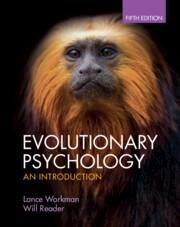Book contents
- Evolutionary Psychology
- Reviews
- Evolutionary Psychology
- Copyright page
- Dedication
- Contents
- Figures
- Tables
- Boxes
- Foreword
- Preface
- 1 Introduction to Evolutionary Psychology
- 2 Principles of Evolutionary Change
- 3 Sexual Selection
- 4 The Evolution of Human Mate Choice
- 5 Cognitive Development, Modularity and Innateness
- 6 Social Development and Morality
- 7 The Evolutionary Psychology of Social Behaviour: Kin Relationships and Conflict
- 8 The Evolutionary Psychology of Social Behaviour: Reciprocity and Conflict
- 9 Evolution, Thought and Cognition
- 10 The Evolution of Language
- 11 The Evolution of Emotion
- 12 Evolutionary Psychopathology and Darwinian Medicine
- 13 Evolution and Individual Differences
- 14 The Evolution of Culture
- Glossary
- References
- Index
- References
5 - Cognitive Development, Modularity and Innateness
Published online by Cambridge University Press: 30 October 2025
- Evolutionary Psychology
- Reviews
- Evolutionary Psychology
- Copyright page
- Dedication
- Contents
- Figures
- Tables
- Boxes
- Foreword
- Preface
- 1 Introduction to Evolutionary Psychology
- 2 Principles of Evolutionary Change
- 3 Sexual Selection
- 4 The Evolution of Human Mate Choice
- 5 Cognitive Development, Modularity and Innateness
- 6 Social Development and Morality
- 7 The Evolutionary Psychology of Social Behaviour: Kin Relationships and Conflict
- 8 The Evolutionary Psychology of Social Behaviour: Reciprocity and Conflict
- 9 Evolution, Thought and Cognition
- 10 The Evolution of Language
- 11 The Evolution of Emotion
- 12 Evolutionary Psychopathology and Darwinian Medicine
- 13 Evolution and Individual Differences
- 14 The Evolution of Culture
- Glossary
- References
- Index
- References
Summary
Rather than thinking of nature versus nurture it is better to think about interactions between genes and the environment. The Santa Barbara School of evolutionary psychology proposed that human cognition is the result of innately specified domain-specific mental modules. Babies have certain expectations of the way that the physical world operates. Infants of at least three months of age have the knowledge that objects exist independently of their ability to perceive them. Babies have preference for face-like stimuli from birth and learn the details of human faces rapidly. Young children have an understanding of the role of mental states as a cause of behaviour. This skill, known as theory of mind, becomes more sophisticated as children develop. It is measured by a number of tasks such as false belief task and the eyes test, in which participants are required to judge how people feel from looking at their eyes.
Keywords
Information
- Type
- Chapter
- Information
- Evolutionary PsychologyAn Introduction, pp. 117 - 140Publisher: Cambridge University PressPrint publication year: 2025
References
Further Reading
Accessibility standard: WCAG 2.0 A
Why this information is here
This section outlines the accessibility features of this content - including support for screen readers, full keyboard navigation and high-contrast display options. This may not be relevant for you.Accessibility Information
Content Navigation
Allows you to navigate directly to chapters, sections, or non‐text items through a linked table of contents, reducing the need for extensive scrolling.
Provides an interactive index, letting you go straight to where a term or subject appears in the text without manual searching.
Reading Order & Textual Equivalents
You will encounter all content (including footnotes, captions, etc.) in a clear, sequential flow, making it easier to follow with assistive tools like screen readers.
You get concise descriptions (for images, charts, or media clips), ensuring you do not miss crucial information when visual or audio elements are not accessible.
You get more than just short alt text: you have comprehensive text equivalents, transcripts, captions, or audio descriptions for substantial non‐text content, which is especially helpful for complex visuals or multimedia.
Visual Accessibility
You will still understand key ideas or prompts without relying solely on colour, which is especially helpful if you have colour vision deficiencies.
Structural and Technical Features
You gain clarity from ARIA (Accessible Rich Internet Applications) roles and attributes, as they help assistive technologies interpret how each part of the content functions.
